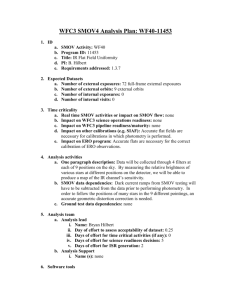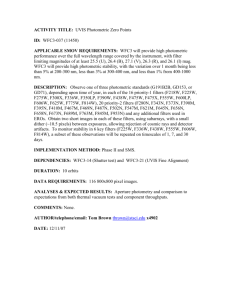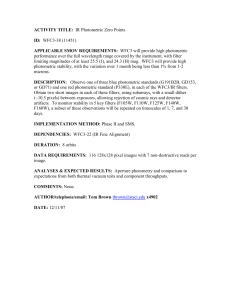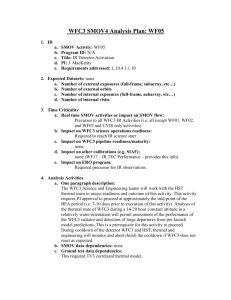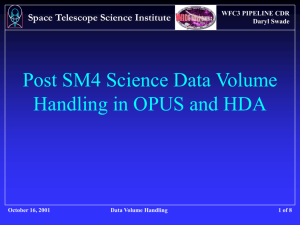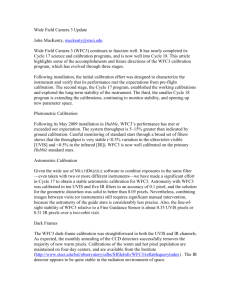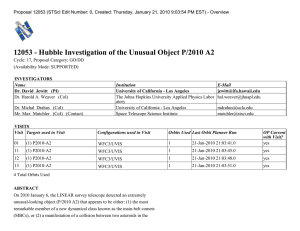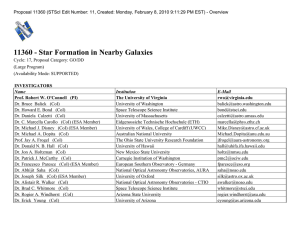PowerPoint
advertisement
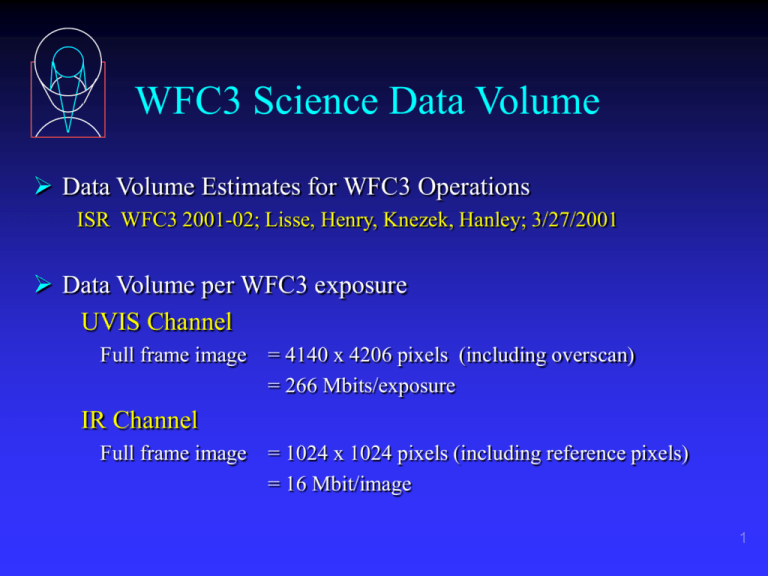
WFC3 Science Data Volume Data Volume Estimates for WFC3 Operations ISR WFC3 2001-02; Lisse, Henry, Knezek, Hanley; 3/27/2001 Data Volume per WFC3 exposure UVIS Channel Full frame image = 4140 x 4206 pixels (including overscan) = 266 Mbits/exposure IR Channel Full frame image = 1024 x 1024 pixels (including reference pixels) = 16 Mbit/image 1 WFC3 Primary Data Volume Observing time allocation assumptions One third of orbits are used for spectroscopy and two thirds for imaging Imaging is divided evenly between WFC3 and ACS (5 orbits/day each) 60% of WFC3 primary orbits will use the UVIS channel (3 orbits/day) 40% of WFC3 primary orbits will use the IR channel (2 orbits/day) WFC3 ETC was used to determine the number of exposures per orbit for each filter used in 41 DRM proposals UVIS exposures assumed CRSPLIT = 2 Number of exposures per orbit was limited to 10 for UVIS and 17 for IR based on the transfer rate out of the WFC3 data buffer and a 60 minute visibility period 2 WFC3 Primary Data Volume Summary of exposure statistics Total number of exposures Total number of orbits Average exposures/orbit UVIS 42,361 9,739 4.4 IR 29,053 5,140 5.7 Primary UVIS data volume 266 Mbits/exp * 4.4 exp/orbit * 3 orbits/day = 3461 Mbits/day Primary IR data volume Average number of nondestructive readouts = 10 Average data volume per exposure = 16 Mbits/image * 10 images/exp 160 Mbits/exp * 5.7 exp/orbit * 2 orbits/day = 1808 Mbits/day 3 WFC3 Parallel Data Volume Assume WFC3 is in parallel for all non-prime orbits 30% of WFC3 parallel orbits will use the UVIS channel (3 orbits/day) 70% of WFC3 primary orbits will use the IR channel (7 orbits/day) Assume an average of 2 exposures per parallel orbit for UVIS and IR Parallel UVIS data volume 266 Mbits/exp * 2 exp/orbit * 3 orbits/day = 1596 Mbits/day Parallel IR data volume Average number of nondestructive readouts = 16 Average data volume per exposure = 16 Mbits/image * 16 images/exp 256 Mbits/exp * 2 exp/orbit * 7 orbits/day = 3584 Mbits/day 4 WFC3 Calibration Data Volume Routine calibration exposures performed during occultations Internal Flats Earth Flats Dark Frames Bias Frames Total per cycle UVIS 693 300 208 104 1305 IR 303 300 208 Exposures/day 3.6 2.2 811 Calibration UVIS data volume 266 Mbits/exp * 3.6 exp/day = 950 Mbits/day Parallel IR data volume 256 Mbits/exp * 2.2 exp/day = 568 Mbits/day 5 WFC3 Average Data Volume UVIS Exp/day Mbits/day Primary 13 3471 Parallel 6 1596 Calibration 3.6 950 Total 22.6 6017 Combined WFC3: 50 Exp/day IR Exp/day Mbits/day 11.3 1808 14 3584 2.2 568 27.5 5960 11.7 Gbits/day 6 Post SM4 Average Data Volume WFC3 ACS COS STIS Total Primary 5.2 3.8 0.4 0.2 9.6 Parallel 5.1 5.1 0 0.1 10.3 Calibration 1.5 1.0 0.2 0.1 2.8 Total 11.7 9.9 0.6 0.4 22.6 Average daily data volume in Gbits without overheads 7 Average Data Volume Trend (Gbit) Prime 2.1 5.0 9.6 SM2 SM3 SM4 190 Par 1.8 8.3 10.3 Cal 1.5 3.2 2.8 Daily 5.3 16.5 22.6 Weekly (w overheads) 48 150 190 Gbit/week is 80% of the 245 Gbit maximum using one transmitter Test SMSs with 150 Gbit of science data have shown the feasibility of scheduling at 60% of TDRSS capacity using both HST SSRs to buffer data (High data Volume SMSs and TDRS Contact Usage, Patterson et al, 5/18/200) Using two HST transmitters raises maximum weekly downlink to 440 Gbit but transmitter lifetime concerns make operating in this mode undesirable. 8
